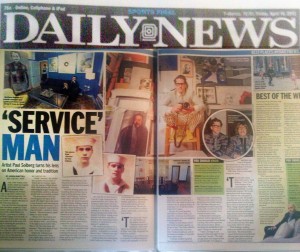SERVICE MAN

Artist, New Yorker, lover of life, respecter of great American traditions, photographer Paul Solberg is all of those. Like a superhero undercover as an unassuming alias, Solberg takes to his bike with camera in tow to capture the hum of life that surrounds us.
You can find him buying kale from the street market at Union Square, taking in the day on the steps of the public library on 42nd St., or sitting casually at a café in the West Village around dusk. In a colorful sweater, hair waving, glasses planted on his nose, Solberg is enjoying the moment as much as capturing it.
His new photography exhibition at Casa de Costa, a cutting-edge art gallery in the Financial District, shows the mystical, hopeful, and timeless world in which Solberg lives, or wishes we could all live.
Called “Service,” the exhibition includes 20 portraits of American servicemen taken over the course of Fleet Week 2010. Taken with a SX-70 Polaroid using damaged vintage film, the portraits combine a dreamy world with one horribly realistic.
The seriousness of war balanced against the faces of the youth who fight it give the series a sense of gravity and haunting levity. None of the servicemen, all in uniform, have names. Taken in a time of revelry, at sunset, in Times Square, the plight of the series takes on more weight.
"These were the easiest and most gracious subjects I have ever worked with," said Solberg. "I thought some would be like, 'Shove off.' But they were the opposite. They were kind of honored. I was taken by that."
Originally, Solberg took hundreds of portraits. However, within days, almost all of them vanished due to instability of the old film. Solberg was left with only 22 photographs that he had fortunately scanned.
"Instead of being upset and moaning about all that was ruined, it all became part of the story," said Solberg. "It almost made what I did have better."
To create the mystical quality of the portraits, Solberg treated the film with dry ice. The vintage quality of the film, which Solberg had lying around his Flatiron studio, gave the artist what he wanted in the form of a finished product. Printing the larger versions himself, another part of Solberg's artistic process, allowed him to control the output and delicate tone.
"After I took the first pictures, the entire project explained itself to me," said Solberg. "I wanted nothing sentimental. I wanted something universal. You look at these, and it can take you back to World War II."
Showing for the first time at Casa de Costa, located on the penthouse floor of 11 Stone Street, Solberg's show looks at home. One reason is because the gallery is designed to look like a private residence or art salon. It has a formal dining room with Chippendale furniture, a large wrap-around roof deck, and offices that look like charming studies in colonial era homes punctuated with modern art.
Solberg likes the relationship with Costa and company. The artist formed a creative team with photographer Christopher Makos, apprentice, assistant, friend and member of Andy Warhol's factory. The two believe in art is anchored in collaboration, spirituality, communication, and fun.
T hese guys take chances," said Solberg of the gallery owners. "They know you can't sustain art with these high prices people have to pay in New York. Plus, they have the most fun parties."
Solberg grew up in Minnesota in a family of hobbyists specializing in photography. At 15, he bought his first camera with money he earned working at Pizza Hut. His first trip overseas occurred at 16 when he went to Tokyo to entertain U.S. army personnel stationed in Japan.
He got the travel bug bad, and went to South Africa living with a romance novelist and extravagant school teacher who moonlighted at a crematorium. Today, he and Makos travel the world working together on projects as "The Hilton Brothers," a creative duo of artists who break limitations and all professional molds. A "job," never quite stuck.
"I always worked hard but was hopeless at anything that required a boss," said Solberg. "The best career move is to be fired from a lot of jobs, early in life. You learn who you are. I participated in this frequently; I only wish I would have been fired faster so I wouldn't have wasted so much time."
Solberg takes nothing for granted, and he's grateful for every new encounter and chance meeting. His smile is genuine. His character intact. There are places he would like to see again. Things he wants to do.
"I have cravings to roll around in the mud again in the Dead Sea," he said. "The high you get from that religious mud is unbelievable. I'm happy at any four-way-stop in Vietnam. It would be fun to take over an abandoned building in Palermo, Sicily for a couple months."
Still, New York is and might always be home.
"This city still values ideas over status," said Solberg. "I love New York because of its contradictions. We're tolerant and intolerant, usually for the right reasons. We're self-assured and self-deprecating. We celebrate the unfamiliar, a rare American trait. We loathe stupidity but love sincerity. I get goose bumps down food lover's lane, which is Bleecker Street in the W. Village. Maybe bike down to China Town for a steam pork bun and end up schlepping bags of fresh fruit and acupuncture needles, all for under $20. That's living."
That's Solberg.
Fashion icon Calvin Klein has his own opinions of the “Service” series. “Paul Solberg’s soldiers photos are subtle and reflective, said Klein. “Paul captured the innocence of those offering their lives to serve our country beautifully. His photos are both fragile and powerful at once.”